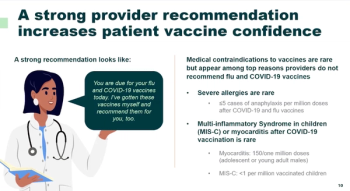
The promise of a new intranasal flu vaccine: Better protection, less side effects
NasoVax is still in the development stages but may eventually provide an option for patients who are immunocompromised.
A new option for influenza vaccination may be on the horizon-and it doesn’t involve a shot.
NasoVax is an intranasal vaccine that in
William J. Enright, president and chief executive officer of Altimmune, Inc., the company developing NasoVax, said the new vaccine aims to address limitations of current influenza vaccine options.
“Clinicians are aware of limitations of the currently licensed influenza vaccines-a poor match to circulating strains, issues with vaccines grown in eggs; inadequate immunity at the local site of infection; inadequate durability of immune response that may not last all the way through flu season, and insufficient cellular immune response,” Enright said.
“We believe NasoVAX addresses many of these concern-a vaccine that is not egg-based and that provides a durable serum antibody response along with a significant IgA (mucosal) antibody response and cellular immune response.”
NasoVAX is based on the adenovirus, a common respiratory virus that is designed to infect nasal epithelium and produce the flu protein hemagglutinin (HA).
“Once it does this, it cannot replicate or spread from cell to cell, but the HA produced locally in the nose drives a broad immune response involving IgA, IgG, innate and cellular immunity,” Enright said.
The backbone adenovirus that makes up NasoVAX will stay the same each year even if the HA protein it produces is changed. It is adapted for mammalian cells. It does not need to replicate to produce HA and drive an immune response,” Enright explained.
“Due to the intranasal delivery, NasoVAX stimulates multiple arms of the immune system including antibodies both at the site of infection (mucosal) and in the blood as well as a T cell response,” he added. “Antibodies are important for preventing infection while T cells are important in killing infected cells, thereby lessening disease severity and potentially protecting against mismatched strains.”
Other intranasal vaccines have been offered, like FluMist, but Enright said NasoVAX differs in that it does not need to replicate in order to generate an immune response.
“This makes it theoretically safer and we hope it will be licensed for use in a wider age range,” Enright said.
While commercial availability of NasVAX is still several years away, Enright said early research shows that the vaccine may be available to populations who can’t receive traditional vaccines, such as patients who are immunocompromised.
Newsletter
Stay informed and empowered with Medical Economics enewsletter, delivering expert insights, financial strategies, practice management tips and technology trends — tailored for today’s physicians.








